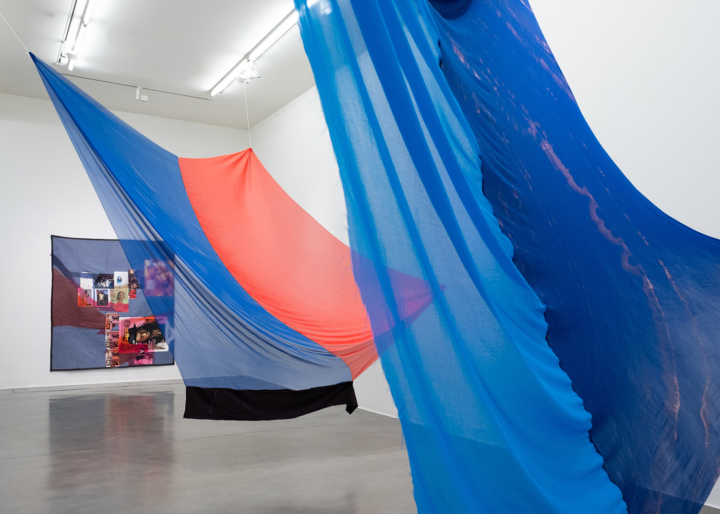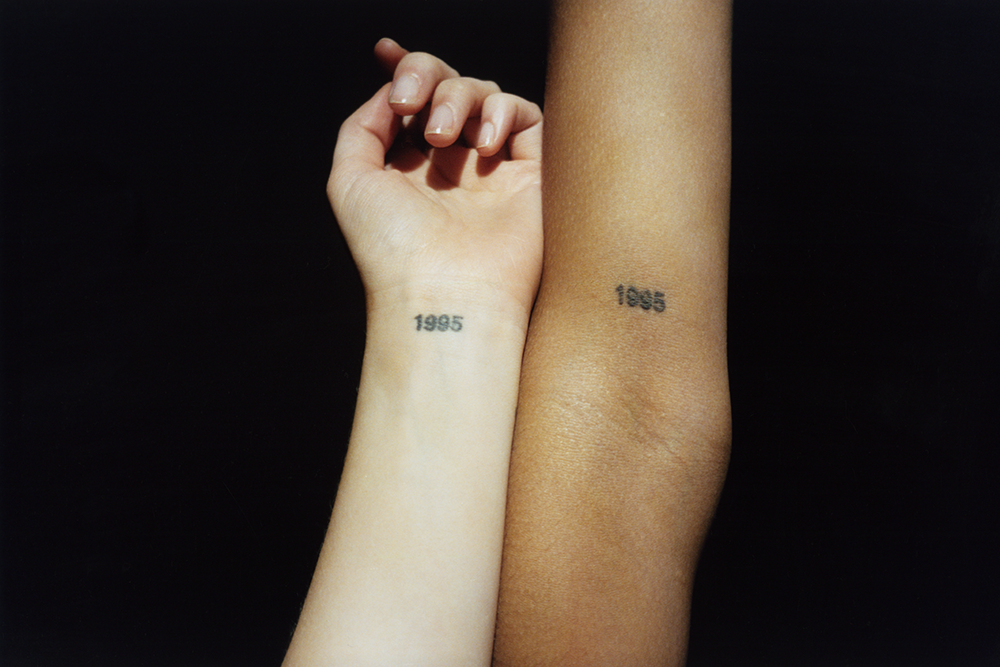
Eric N. Mack (b. 1987, US; lives in New York) interrogates the nature of painting by creating assemblages that dynamically combine worn clothes, moving blankets, torn rags, and other used textiles amid painted or dyed surfaces and images from books and magazines. Mack met with Jessica Bell Brown. Together they discuss how the tactility of Mack’s materials and their constant echo of the human body infuse his artworks with a performative quality that intimates the communicative potential of the fashion item.
Jessica Bell Brown: It seems as though your interest in fashion is becoming highly articulated in a way that’s visible and palpable, assertively so. I’m wondering if that’s true, and if so, how did you arrive at this moment to be so bold and daring. You come out of Yale — painting — and you’re thinking about painting in a more expansive way. But then the fashion has always been there, and it seems to be something you’re contending with maybe equally.
Eric N. Mack: Yeah. I think it’s a line that I’d always wanted to bring in. Mostly because I felt like it was already inherent in some of the explorations of painting. That it was like a good, kind of poetic, congruent relationship — rather than a “like” or “as” — for it to actually break the frame and attach itself to the viewer in a more responsive, more emotional way. I mean, it’s that kind of a drama that I’m forever trying to unpack, but also locate in a way that’s flexible — and, I think, democratically beautiful in a way that many people talk about, without the discourse of painting, and maybe being tricked into engaging with its history without knowing it.
When you say democratically beautiful, I imagine that it’s something different when you’re thinking about the influence of painting in art history versus the everydayness of materials and things, fabrics and clothes. In your work, it seems you’re challenging the idea of beauty on different fronts.
Yeah, absolutely.
So a “beautiful painting” — and we’re using air quotes — is not necessarily on par with what a beautiful garment could look like.
Right. Exactly. I feel like some of the complications of my own eye was considering a real personality in people who regarded those things as linked. Something being really quite legible about the expression in how a person is able to put themselves together. There’s something about the ease of that, in the everyday context, meeting the struggle and the forcefulness and the intention that would involve a painted object and the pursuit of a point of beauty in a vigorous painting object, which I love. You know, it still is like a real active hybrid of those forces.
I think that is actually part of the innovation with something like that, or part of the aspiration of the invention, because these things aren’t really dependent on a singular body. They’re contingent on my body, actually. But the openness is to allow for several different types of projections. Mostly one that’s quite physical as a presence, physical as a form. Not a picture that’s limitless. You know, very much like a picture grounded in the real, so reverberations of those affirmations that exist both within blackness and dimensionality, form, and texture — those things have an opportunity for legibility.
I was going to ask you about the role of abstraction in your work, but maybe what I’m really asking is how is abstraction rendered for you, and how do you make use of it? When I look at your work, I’m seeing this culmination of a bunch of different things and matters that are tangible and connected to the real world, but when they’re unified there is this premise about abstraction that’s happening.
Right. I definitely want to try to make a record of the familiar, just to see the abstraction in everyday things. And not just a part of a tangibility, a gesture or estrangement — it’s a world we live in that sits adjacent to understanding. Understanding our bodies, understanding space, understanding feeling.
It sounds like abstraction is a potential.
You know, the base relationship to abstraction has always been to fragment. Cutting something up into parts and examining exactly what renders it operational to the next essential part. And I think that’s really been a way of grounding abstraction as a kind of research that works or something… that’s operational, that’s measured, that’s intentional. I’m thinking that abstraction could just be the whole frame; it could be something more whole, actually. A whole form, probably not something small. And I’m also thinking about gaps in understanding like a kind of algebraic equation or something.

I want to ask you about your collaboration with Grace Wales Bonner on her AW18 runaway show. This has something to do with this line of thinking about abstraction, because I think fashion requires a kind of legibility. Whereas I think artists get a lot more leeway. You don’t have this problem of wearability that designers have to contend with constantly. So how did your and Grace’s thinking come together for her most recent collection? Did you ever talk about this issue and how to work around it? Or how you would work around it as an artist?
With every point of expertise and focus there’s blind spots. I think having each other’s back in those blind spots to be able to develop something really cool was our operation. We talked a lot about the ideas around what her hopes for the collection were, certain textures and references. For example, I’m thinking about a sailor mixed with an Aaron Douglas print. She ended up using Jacob Lawrence as a point of reference on the actual garments. But really we were just thinking about how to mine all of these different points of reference. You know, the wearer is related to some of those points of regard.
Where I found myself had to do with how figures were enveloped and other contradictions — the freedom in the drapery and the freedom in the choice of the textures and the colors, and also the limitation of the black and white [of most of the collection’s garments]. Like, okay, we’re dealing with a specific color palette that I felt like I had to expand to see myself in that space actively. I feel like that’s a part of the abstraction that’s not just about the way that the fabric appeared or the actual choice of cotton versus silk, rayon, polyester, and all that stuff. It really had to do with how these materials were a vehicle for color — finding these loopholes that enhanced the light that was in that place as a visual opportunity.
So it wasn’t really a background; it was a kind of collaborator. It’s coextensive with the garments that were worn by the models.
Exactly. I mean, just the fact that the fabric was able to breathe and move in that space because of the momentum of the models themselves, being able to brush up against it. It was a pretty extensive installation. There was this mix of fabric that was a 1970s wool curtain that was made with a gauzy transparency. It was striped and it was mended with a catamaran sail, and it had a string coming down that had some kind of practical use. The runway was shaped like a C, so the models walked around into a cavernous situation and then turned around and walked back out. The string dangled over the heads of the models. The models end up walking around this string that was dangling, and that was the thing that actually physically touched them.
Talk to me about Carl Van Vechten. I know he was a huge reference for both you and Grace. Are we talking about the studio portraits of folks within the Harlem Renaissance?
Right. I mean, ultimately it’s just about phenomenal performers from that time. People who won Tonys, Academy Awards, Grammys in the 1940s, ’50s, ’30s in some cases. There are also the dance portraits. Just to see something that was explicitly costume on a body in motion, and somehow the background contributed to a kind of distancing. It was all a choice, and it seemed like there was so much that was framed and exoticized within the sitters and the performers. It’s interesting to see his contextual backdrops, which felt like a confused, impulsive interior decorator with very good taste.
He’s such a mythological figure to me. You have someone with such mobility deep within one of the inner recesses of arguably the most budding moments in black cultural production. It’s an interesting foil, because whereas in your work there is the absence of the body, in Van Vechten’s it’s predicated upon the performances of the body in space and time. Even the performance that’s happening in the studio, but also the idea that these folks in their creative life work are performers, you know?
Captivity is something I kept thinking about. This moment that they are in the studio for some time, and it’s all about them leaving and what they do after, or what they’ve done after. People were pregnant with potential, you know? Almost like Warhol and the screen tests. This produced a palette, this frame of the seated portrait. People would just come through and chill and hang out, and they get seated for a portrait. It’s very New York. It’s like a downtown club or something like that. You go to the club and somebody pulls you aside because they think you’re interesting looking, the way you wear it. People are curious about your image and they sit you behind a consistent backdrop and take a photo, and then you go back to the party. And then you leave the party or you maybe go to work, maybe you don’t. Maybe you party more. A little bit more like a considered art frame or something like that, through that kind of abstraction from everyday.

So let’s pivot to the show at Simon Lee. Did you find that you were articulating some things that emerged from your work with Grace? What kind of risks do you think you were taking?
I was really thinking about transparency and layering with color, and also just giving myself permission to follow up from that expression because it happened so quickly before. I wanted something that would be coherent. Because actually, Simon Lee and where we did the runway show in Belgravia is like basically down the street and around the corner. Belgravia is one of the oldest and wealthiest areas in London. There’s a bunch of embassies around there — basically it’s down the street from Buckingham Palace. So it has this regal frame and attention to the most British identity, which is the royal family and that kind of thing.
So then you have this show — “Misa Hylton Brim” — that references the golden era of late 1990s, early 2000s hip-hop. When you put it that way, the gesture is beyond the objects.
Right. It is literally about being able to take something as your own and flip it to… I don’t know. I just imagine Lil’ Kim walking past Buckingham Palace, but not being able to enter it, wearing some great Versace look; or think about Rihanna wearing the Pope’s hat [at the Met Gala]. There’s that kind of thing, being about a feeling. But it’s more than just regality. It’s about self worth. It’s about worth and documenting that worth and the trace of that worth. I think fashion at its best is about intangibility. It’s about the thing you can’t have. Even if you have it, you can’t have it.
Right. It’s a limited resource. It’s also a luxury.
And it’s also not about the physical form. It’s about the ways of the physical form. It’s about the way that a cloth drapes, the way that something is wrapped around your waist. You know what I mean? And it doesn’t matter if you have the papal vestment or you have the sweat pants and the drop socks and the Reebok Princess. Just the feeling of power ends up being quite physical in communication to the relationship between the body and the form that it takes — the garment also being part of the form that it takes. The structure, the exposure, the vulnerability. So there’s a real formality that is very alive to me. And there’s something about the drama, the performance of fashion as being something that’s really active and alive. I know that it’s a point of communication because other people participate in it.





